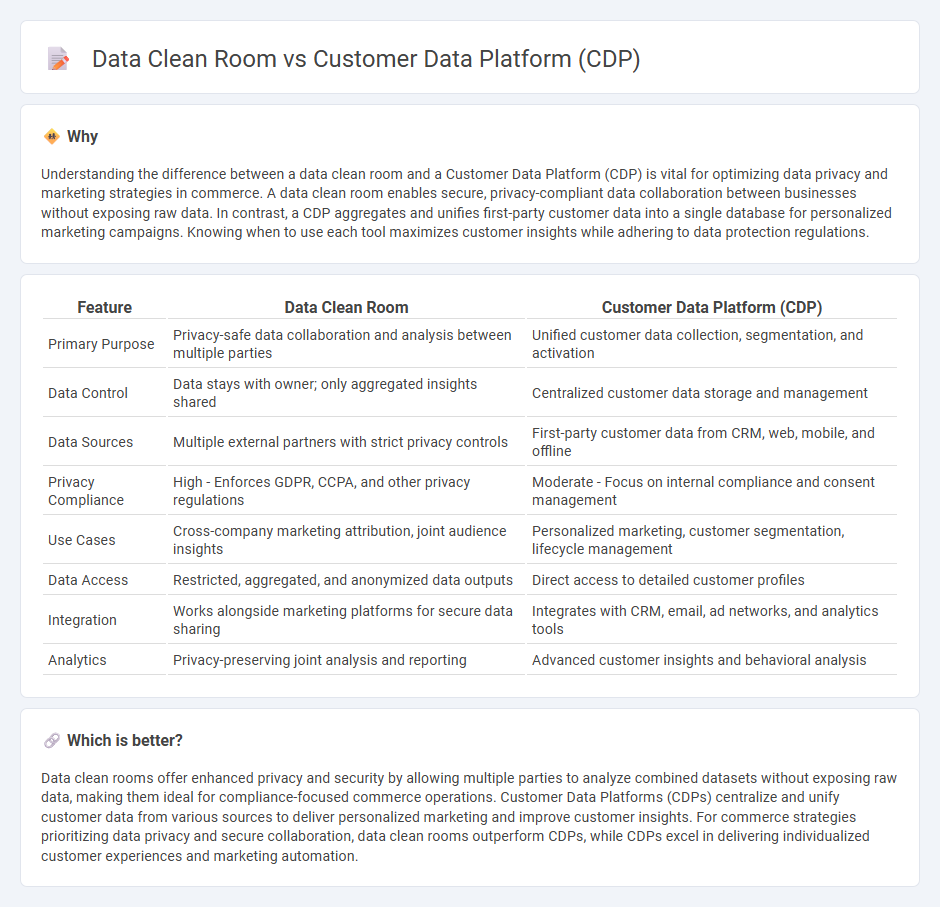
Data clean rooms enable secure, privacy-compliant data collaboration by allowing multiple parties to analyze combined datasets without exposing raw information. Customer Data Platforms (CDPs) aggregate and unify customer data from various sources to create comprehensive profiles for personalized marketing and analytics. Explore how these technologies can transform commerce strategies by enhancing data privacy and customer insights.
Why it is important
Understanding the difference between a data clean room and a Customer Data Platform (CDP) is vital for optimizing data privacy and marketing strategies in commerce. A data clean room enables secure, privacy-compliant data collaboration between businesses without exposing raw data. In contrast, a CDP aggregates and unifies first-party customer data into a single database for personalized marketing campaigns. Knowing when to use each tool maximizes customer insights while adhering to data protection regulations.
Comparison Table
| Feature | Data Clean Room | Customer Data Platform (CDP) |
|---|---|---|
| Primary Purpose | Privacy-safe data collaboration and analysis between multiple parties | Unified customer data collection, segmentation, and activation |
| Data Control | Data stays with owner; only aggregated insights shared | Centralized customer data storage and management |
| Data Sources | Multiple external partners with strict privacy controls | First-party customer data from CRM, web, mobile, and offline |
| Privacy Compliance | High - Enforces GDPR, CCPA, and other privacy regulations | Moderate - Focus on internal compliance and consent management |
| Use Cases | Cross-company marketing attribution, joint audience insights | Personalized marketing, customer segmentation, lifecycle management |
| Data Access | Restricted, aggregated, and anonymized data outputs | Direct access to detailed customer profiles |
| Integration | Works alongside marketing platforms for secure data sharing | Integrates with CRM, email, ad networks, and analytics tools |
| Analytics | Privacy-preserving joint analysis and reporting | Advanced customer insights and behavioral analysis |
Which is better?
Data clean rooms offer enhanced privacy and security by allowing multiple parties to analyze combined datasets without exposing raw data, making them ideal for compliance-focused commerce operations. Customer Data Platforms (CDPs) centralize and unify customer data from various sources to deliver personalized marketing and improve customer insights. For commerce strategies prioritizing data privacy and secure collaboration, data clean rooms outperform CDPs, while CDPs excel in delivering individualized customer experiences and marketing automation.
Connection
Data clean rooms and Customer Data Platforms (CDPs) connect through their roles in managing and analyzing consumer information while prioritizing privacy and security. A data clean room enables multiple parties to collaborate on aggregated, anonymized datasets without exposing raw data, complementing a CDP's function of unifying first-party customer data to create detailed, privacy-compliant profiles. Together, they enhance personalized marketing strategies and data-driven commerce decisions by ensuring data integrity and regulatory compliance within complex ecosystems.
Key Terms
Data Integration
Customer Data Platforms (CDPs) centralize customer data from multiple sources to create unified profiles, enabling personalized marketing and analytics. Data clean rooms prioritize privacy by allowing brands to analyze combined datasets without exposing raw data, ensuring compliance with data protection regulations. Discover how each solution transforms data integration strategies for enhanced customer insights.
Privacy Compliance
Customer Data Platforms (CDPs) aggregate and unify customer data to create comprehensive profiles while ensuring privacy compliance through consent management and data anonymization. Data clean rooms enable multiple parties to analyze shared data securely without exposing raw information, maintaining GDPR and CCPA compliance through strict access controls and encryption. Explore how these solutions enhance privacy compliance in modern data ecosystems.
Audience Segmentation
Customer Data Platforms (CDPs) consolidate first-party customer data to create unified profiles, enabling precise audience segmentation based on behavioral and demographic attributes. Data clean rooms aggregate anonymized data from multiple sources while preserving privacy, facilitating audience analysis without exposing raw data or personal identifiers. Explore how integrating CDP capabilities with data clean rooms can enhance your audience segmentation strategies.
Source and External Links
What is a CDP? A Complete Guide for Customer Data ... - A Customer Data Platform (CDP) is a centralized database that unifies customer profiles across multiple data silos to enable personalized marketing, customer experience, and compliance with data privacy laws by integrating first, second, and third-party data for a single source of truth.
What is a customer data platform? (CDP) - A CDP is a marketer-managed platform providing a unified, persistent customer database with out-of-the-box integrations, enabling easy data collection, segmentation, and orchestration without heavy IT involvement, differing from CRM and DMP by focusing on individual-level data transparency and omnichannel marketing acceleration.
What is a Customer Data Platform (CDP)? - A CDP consolidates customer data from all channels into real-time unified profiles, combining databases like CRM and e-commerce to empower businesses to understand customers deeply and create personalized experiences, serving as a core tool for multichannel campaign management and customer relationship enhancement.
 dowidth.com
dowidth.com